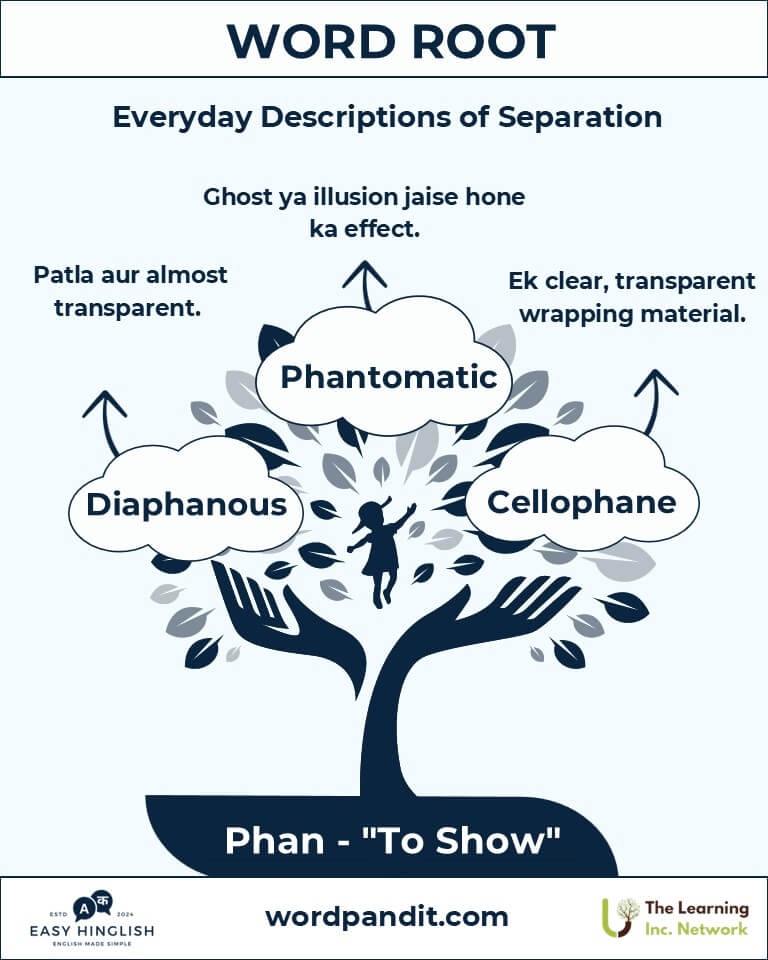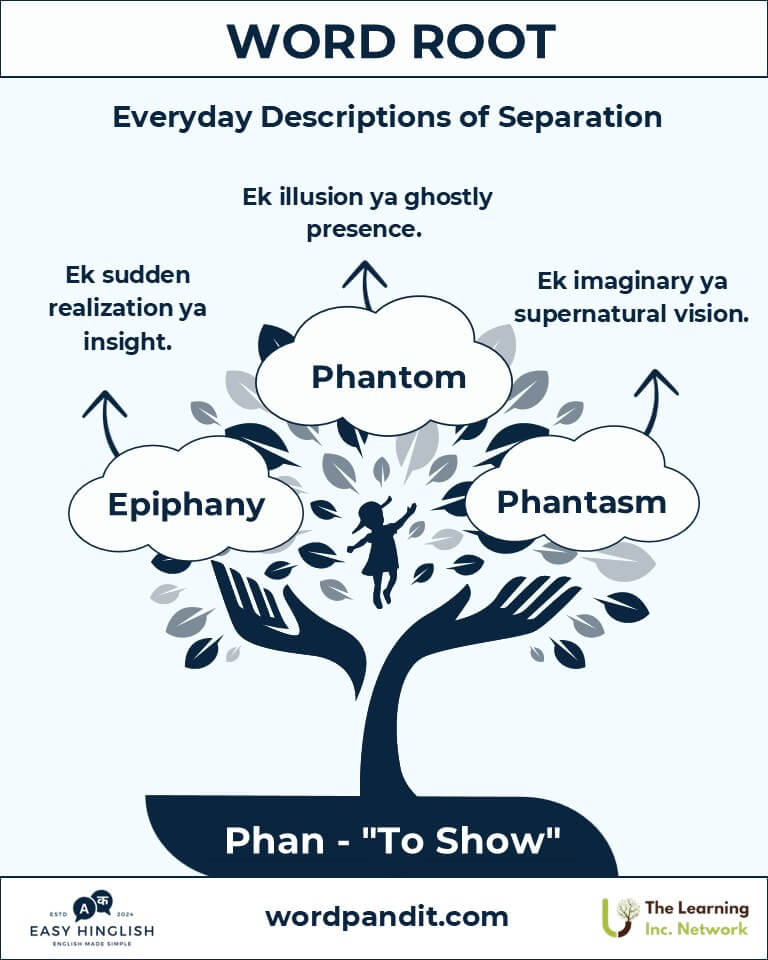Phan: The Art of Showing and Revealing in Language and Expression
(Phan: Bhasha aur Abhivyakti mein Dikhane aur Prakat Karne ki Kala - फैन: भाषा और अभिव्यक्ति में दिखाने और प्रकट करने की कला)
Discover the fascinating versatility of the root "Phan," originating from Greek, meaning "to show" or "to appear." From the translucent charm of "diaphanous" to the profound clarity of an "epiphany," this root has shaped words that illuminate concepts, reveal truths, and bring ideas to light.

Table of Contents
- Introduction: The Magic of "Phan"
- Etymology and Historical Journey
- Mnemonic: Unlocking the Power of "Phan"
- Common "Phan"-Related Terms
- "Phan" Through Time
- "Phan" in Specialized Fields
- Illustrative Story: "Phan" in Action
- Cultural Significance of "Phan"
- The "Phan" Family Tree
- FAQs About the "Phan" Word Root
- Test Your Knowledge: "Phan" Mastery Quiz
- Conclusion: The Radiance of "Phan"
Introduction: The Magic of "Phan"
("Phan" ka Jadoo - "फैन" का जादू)
Kya cheez ek diaphanous gown ki delicate transparency ko aur ek life-changing epiphany ki profound clarity ko connect karti hai? Yeh dono "Phan" root se jude hain, jo Greek language se aaya hai aur iska matlab hai "to show" (दिखाना) ya "to appear" (प्रकट होना). Yeh root clarity, revelation, aur light ko symbolize karta hai. "Phan" ka magic humein understanding aur enlightenment deta hai.
Etymology and Historical Journey
("Phan" ki Utpatti aur Itihaas - "फैन" की उत्पत्ति और इतिहास)
- Root Origin: "Phan" root ka origin Greek word "phainein" se hai, jiska matlab hai "to show" (दिखाना) ya "to bring to light" (रोशनी में लाना).
- Latin Influence: Yeh Latin mein "phan-" ke roop mein aaya aur phir Old French aur English vocabulary mein merge ho gaya.
- Greek Philosophy: Greek philosophers aur playwrights jaise Plato aur Sophocles ne "Phan" derivatives ka use kiya apne works mein, jo themes of revelation aur truth ko explore karte the.
Mnemonic: Unlocking the Power of "Phan"
(Mnemonic ke Zariye "Phan" ko Yaad Rakhein - Mnemonic के ज़रिए "Phan" को याद रखें)
Imagine kariye ek beam of light jo ek curtain ke through pass ho rahi hai, vivid shadows aur forms create karti hui. Yeh imagery "Phan" ko perfectly represent karti hai, jo "showing" aur "unveiling" ka act symbolize karta hai.
Mnemonic Device: "Phan shows what’s unseen, like light through a translucent screen."
Common "Phan"-Related Terms
("Phan" se Jude Common Shabd - "फैन" से जुड़े आम शब्द)
- Diaphanous (डायाफेनस): Light, delicate, aur almost transparent.
Example: "Diaphanous curtains ne morning sunlight ko softly room mein filter karne diya." - Epiphany (एपिफ़ेनी): Ek sudden aur striking realization ya insight.
Example: "Apne walk ke dauraan usse ek epiphany mili jo uske problem ka solution ban gayi." - Phantom (फैंटम): Ek ghost ya illusion.
Example: "Sailors ek shipwrecked vessel ke phantom se haunted the." - Phenomenon (फेनॉमिनन): Ek observable fact ya event, jo aksar extraordinary hota hai.
Example: "Northern lights ek natural phenomenon hain jo duniya bhar ke viewers ko captivate karte hain." - Cellophane (सेलोफेन): Ek thin aur transparent wrapping material.
Example: "Usne gift ko colorful cellophane mein wrap kiya festive touch ke liye."
"Phan" Through Time
(Samay ke Saath "Phan" ka Safar - समय के साथ "फैन" का सफर)
- Phantasm (Ancient): Ek imagination ka figment ya ek illusion.
Context: Medieval literature mein supernatural visions describe karne ke liye use hota tha. - Phenomenal (Modern): Remarkable ya extraordinary.
Context: Pehle strictly observable phenomena ke liye use hota tha, lekin ab awe-inspiring achievements ko describe karne ke liye bhi use hota hai.
"Phan" in Specialized Fields
(Vishesh Kshetron mein "Phan" ka Upyog - विशेष क्षेत्रों में "फैन" का उपयोग)
- Literature:
- Phantom: Gothic novels mein aksar unresolved conflict ka symbol hota hai.
- Physics:
- Phenomena: Observable events, jaise light ya sound waves ka bending.
- Art:
- Diaphanous: Visual compositions ya textiles mein ethereal qualities describe karne ke liye.
- Psychology:
- Epiphany: Cognitive therapy ya creativity mein sudden understanding ke moments.
Illustrative Story: "Phan" in Action
("Phan" ki Kahani - "फैन" की कहानी)
Lila apne first fashion show ke liye ek collection design kar rahi thi. Jab usne ek diaphanous fabric ko light ke against hold kiya, to usse ek epiphany mili—woh is material ko bold patterns ke saath blend kar sakti thi. Is blend ne ek phenomenal design create kiya. Uska show ka highlight ban gaya, aur yeh dikhaya ki "Phan" kaise creativity ko illuminate karta hai.
Cultural Significance of "Phan"
("Phan" ka Sanskritik Mahatva - "फैन" का सांस्कृतिक महत्व)
Mythology mein, "Phan" divine revelation ke moments se juda hai, jaise jab gods mortals ke saamne appear hote hain. Modern times mein bhi, yeh clarity aur enlightenment ka symbol hai, poetry, philosophy, aur pop culture mein prominently dikhayi deta hai. Phantoms aur phenomena ne hamesha audiences ko captivate kiya hai.
The "Phan" Family Tree
("Phan" Parivar ke Shabd - "फैन" परिवार के शब्द)
- Fan (Latin): To show ya reveal.
- Fantasy: Imaginative ideas ya stories.
- Luc (Latin): Light.
- Lucid: Clear aur easily understood.
- Spec (Latin): To look ya see.
- Spectacle: Ek visually striking performance ya display.

FAQs About the Phan Word Root
Q: "Phan" ka kya matlab hai, aur iska language mein kya relevance hai?
A: "Phan" Greek se aaya hai aur iska matlab hai "to show" (दिखाना) ya "to appear" (प्रकट होना). Yeh root un words mein hota hai jo revelation (प्रकाशन), display (प्रदर्शन), aur visibility (दृश्यता) ko express karte hain, jaise "diaphanous" aur "epiphany."
Q: "Epiphany" ka origin kya hai aur iska aaj ke time mein kya use hai?
A: "Epiphany" ka origin Greek word "epiphaneia" se hua hai, jiska matlab hai "manifestation" ya "appearance." Traditionally, yeh ek divine revelation ko refer karta tha. Aaj ke time mein, yeh kisi bhi personal moment of clarity ya insight ko describe karta hai, jaise kisi problem ka solution milna.
Q: "Phenomenon" ka kya significance hai aur iska meaning kaise evolve hua hai?
A: "Phenomenon" kisi observable fact ya event ko describe karta hai, jo aksar extraordinary hota hai. Greek word "phainomenon" (जो प्रकट होता है) se derived, iska pehle use science mein natural occurrences ko describe karne ke liye hota tha. Ab iska matlab human achievements aur cultural phenomena ko bhi cover karta hai.
Q: "Phantom" aur "Phantasm" mein kya difference hai?
A: Dono words ka root "phan" hai, lekin inka usage alag hai:
- Phantom: Ek ghost ya shadowy figure ko refer karta hai.
- Phantasm: Ek illusion, hallucination, ya imagination ka figment hota hai.
Phantom physical ho sakta hai, jabki phantasm zyada abstract aur psychological hota hai.
Q: "Diaphanous" ka connection "Phan" se kaise hai?
A: "Diaphanous" Greek roots "dia-" (through) aur "phan" (to show) se bana hai, jiska matlab hai "to show through." Yeh un materials ke liye perfect hai jo light ko pass karne dete hain, jaise sheer fabrics, aur yeh unke delicate aur translucent nature ko emphasize karta hai.
Test Your Knowledge: Phan Mastery Quiz
1. "Phan" root ka kya arth hai?
2. Kaunsa word ek sudden realization ya insight ko describe karta hai?
3. "Diaphanous" ka kya matlab hai?
4. Supernatural visions ya illusions ko kaunsa term describe karta hai?
5. "Phenomenon" ka kya matlab hai?
Conclusion: The Radiance of "Phan"
("Phan" ki Chamak ka Nishkarsh - "फैन" की चमक का निष्कर्ष)
"Phan" root language ko clarity aur revelation ke saath illuminate karta hai. "Diaphanous" designs se lekar "phenomenal" achievements tak, iska influence har field ko enrich karta hai.







